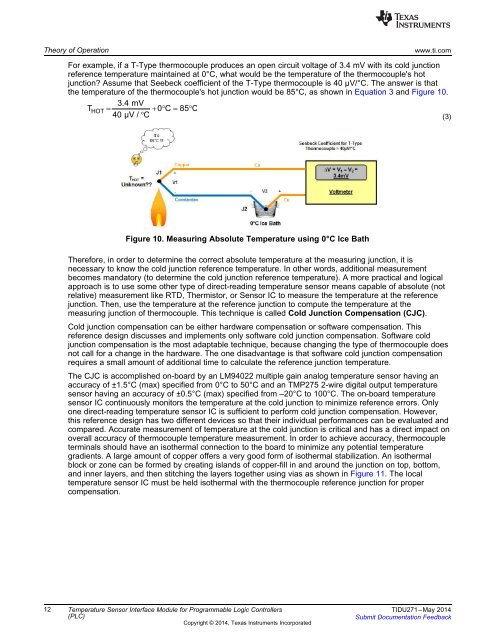tidu271
You also want an ePaper? Increase the reach of your titles
YUMPU automatically turns print PDFs into web optimized ePapers that Google loves.
Theory of Operation<br />
www.ti.com<br />
For example, if a T-Type thermocouple produces an open circuit voltage of 3.4 mV with its cold junction<br />
reference temperature maintained at 0°C, what would be the temperature of the thermocouple's hot<br />
junction? Assume that Seebeck coefficient of the T-Type thermocouple is 40 µV/°C. The answer is that<br />
the temperature of the thermocouple's hot junction would be 85°C, as shown in Equation 3 and Figure 10.<br />
3.4 mV<br />
THOT<br />
0C 85C<br />
40 µV / C<br />
(3)<br />
Figure 10. Measuring Absolute Temperature using 0°C Ice Bath<br />
Therefore, in order to determine the correct absolute temperature at the measuring junction, it is<br />
necessary to know the cold junction reference temperature. In other words, additional measurement<br />
becomes mandatory (to determine the cold junction reference temperature). A more practical and logical<br />
approach is to use some other type of direct-reading temperature sensor means capable of absolute (not<br />
relative) measurement like RTD, Thermistor, or Sensor IC to measure the temperature at the reference<br />
junction. Then, use the temperature at the reference junction to compute the temperature at the<br />
measuring junction of thermocouple. This technique is called Cold Junction Compensation (CJC).<br />
Cold junction compensation can be either hardware compensation or software compensation. This<br />
reference design discusses and implements only software cold junction compensation. Software cold<br />
junction compensation is the most adaptable technique, because changing the type of thermocouple does<br />
not call for a change in the hardware. The one disadvantage is that software cold junction compensation<br />
requires a small amount of additional time to calculate the reference junction temperature.<br />
The CJC is accomplished on-board by an LM94022 multiple gain analog temperature sensor having an<br />
accuracy of ±1.5°C (max) specified from 0°C to 50°C and an TMP275 2-wire digital output temperature<br />
sensor having an accuracy of ±0.5°C (max) specified from –20°C to 100°C. The on-board temperature<br />
sensor IC continuously monitors the temperature at the cold junction to minimize reference errors. Only<br />
one direct-reading temperature sensor IC is sufficient to perform cold junction compensation. However,<br />
this reference design has two different devices so that their individual performances can be evaluated and<br />
compared. Accurate measurement of temperature at the cold junction is critical and has a direct impact on<br />
overall accuracy of thermocouple temperature measurement. In order to achieve accuracy, thermocouple<br />
terminals should have an isothermal connection to the board to minimize any potential temperature<br />
gradients. A large amount of copper offers a very good form of isothermal stabilization. An isothermal<br />
block or zone can be formed by creating islands of copper-fill in and around the junction on top, bottom,<br />
and inner layers, and then stitching the layers together using vias as shown in Figure 11. The local<br />
temperature sensor IC must be held isothermal with the thermocouple reference junction for proper<br />
compensation.<br />
12 Temperature Sensor Interface Module for Programmable Logic Controllers TIDU271–May 2014<br />
(PLC)<br />
Submit Documentation Feedback<br />
Copyright © 2014, Texas Instruments Incorporated



